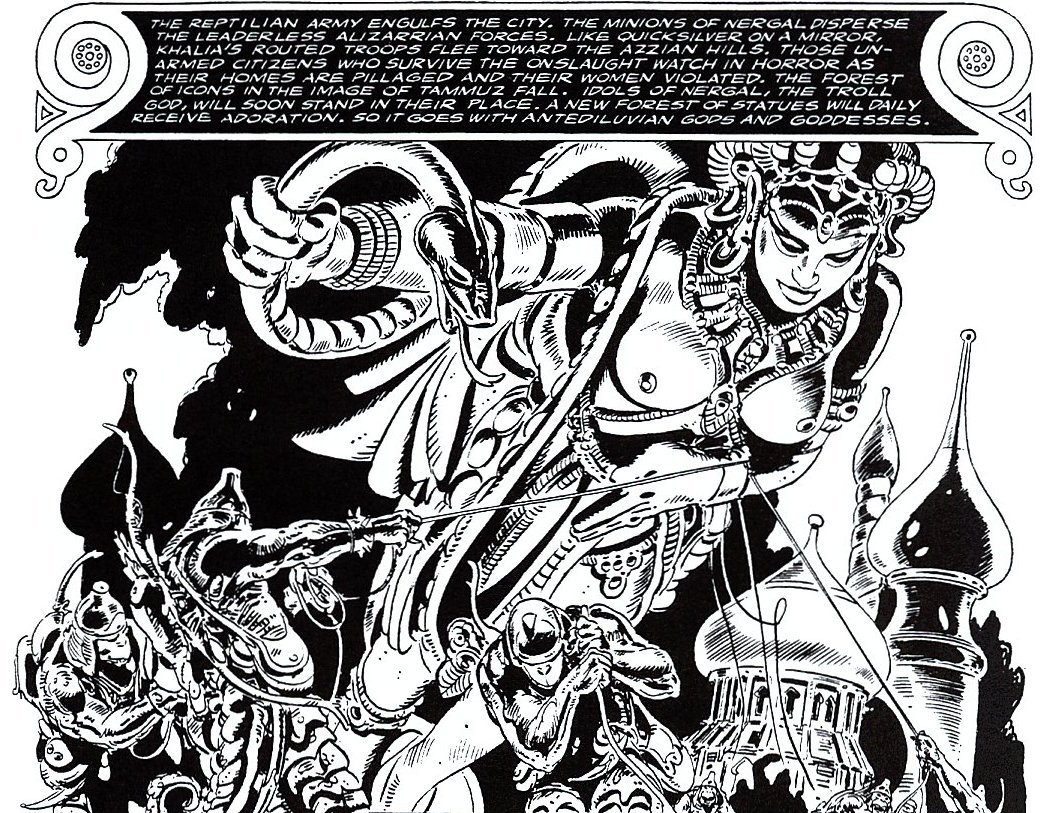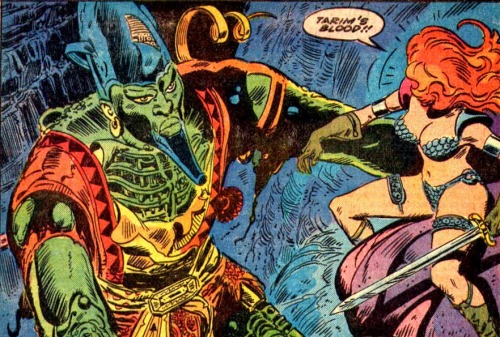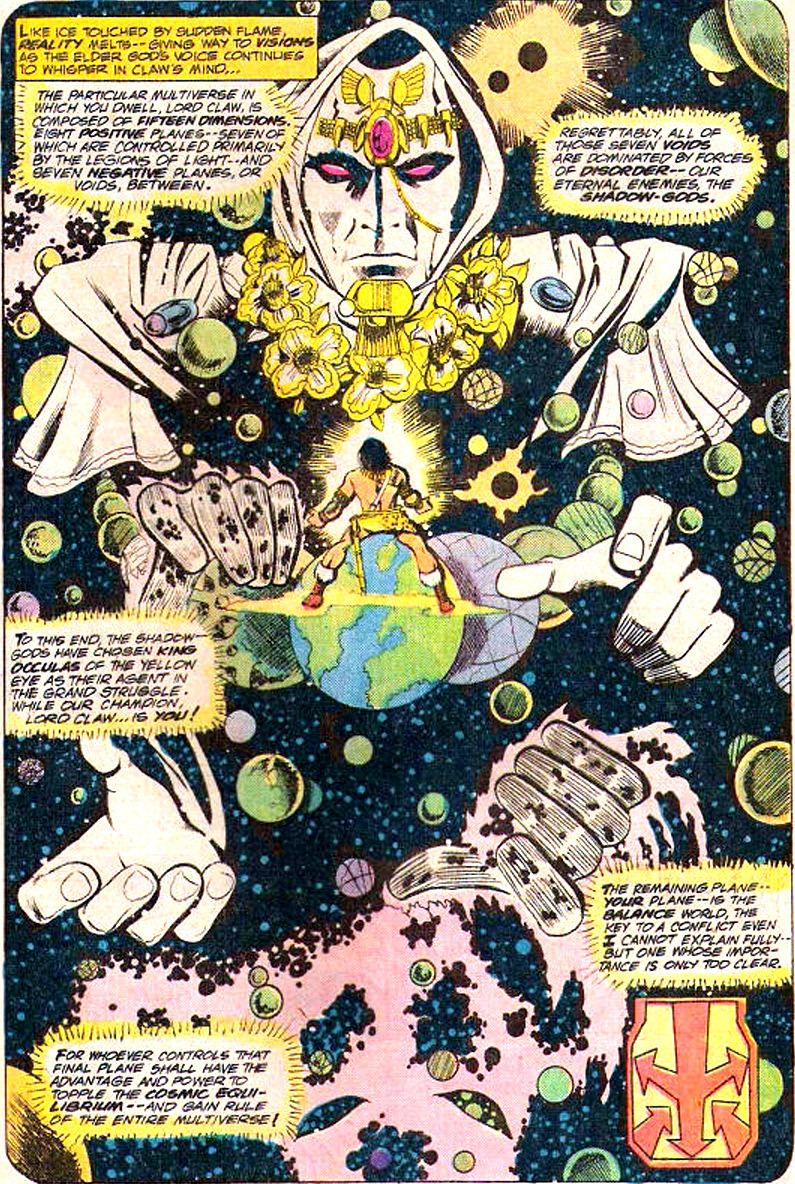6 hours ago
Sunday, December 1, 2019
Weird Revisited: The Dead Travel Fast
In the deserts north of Heliotrope, weird monsters of the outer dark and thrill-crazy youths race hopped-up roadsters across dead sea bottoms.
In Hesperia, a “car culture” has emerged. Like the Southron bootleggers, some young Hesperian men have taken to modifying jalopies for the purpose of drag-racing. Most of the modifications are strictly mechanical, but would-be racers save up for more expensive thaumaturgical or alchemical modifications.
While some racing occurs along highways, the real action is out in the desert. There, on the vast and empty beds left by ancient seas, law enforcement doesn’t intrude, and higher speeds can be reached. The speeds, and the often haphazard modification of the cars, sometimes make these races deadly--but these mundane dangers aren't the only things to fear.
Maybe it was just the psychic energy boiling off youth hopped-up on alchemical drugs, speed, and the proximity of death; or maybe the death of the ancient seas left the skin of reality thin, inviting irruption. Whatever the cause, broken and burned-out husked of roadsters--and sometimes the charred and mangled remains of their drivers--have been reanimated by outer monstrosities in forms as colorful and grotesque as something from a drug delirium nightmare.
Appearances by these creatures are things of fear and wonder for the human racers. The unholy growl of giant engines and the overpowering smell of burning rubber presage their arrival--almost always between the stroke of midnight and first light of dawn. They're practically worshipped as secret and strange god-things. Rituals are performed; crude talismans of twisted steel and burnt chrome are fashioned. The bravest (or craziest) of the young drivers sometimes join in their monster races, and those few that survive with life and limb, and sanity, intact are often dragged along in the creatures' slipstreams as they roar back into the void, and are never seen again
Labels:
campaign settings,
post revisited,
rpg,
weird adventures
Wednesday, November 27, 2019
Wednesday Comics: BABC Podcast: Korg 70,000 B.C. #9
I new episode of the Bronze Age Book Podcast is out! Listen to us ramble about Korg: 70,0000 B.C. #9 on your podcast app of choice!
Listen to "Episode 10: KORG: 70,000 B.C. #9" on Spreaker.
Listen to "Episode 10: KORG: 70,000 B.C. #9" on Spreaker.
Monday, November 25, 2019
Weird Revisited: The Elements of Bronze Age Four-Color Fantasy
By Bronze Age, I mean the Bronze Age of Comics, which largely conicides with the 1970s. Any readers of this blog will know that's an era I have some affection for [since I now do a podcast on it!]--particularly its fantasy comics. These comics (particularly when original to the comics medium and not adaptation) present a flavor of fantasy distinct from other fantasy genres or media.
I feel like this sort of fantasy would make for a good game, and I don't think that's really been done. Warriors & Warlocks supposedly set up to do this, but that supplement really winds up adapting a wider range of fantasy to the Mutant & Mastermind system. I've been trying to think of the elements/tropes of this sort of thing:
1. Very much a “Points of Light” thing with large stretches of wilderness and clusters of civilization.
2. Cities tend to look more fantastic ancient world/Arabian Knights/Cecil B. Demille spectacle than grotty Medievalism
3. Above ground ruins and natural obstacles as more common adventure locales than underground “dungeons.”
4. Fantastic terrain is more common (because it makes for good visuals).
5. Magic-users generally fall into 1 of three categories: 1) almost god-like patrons (who maybe secretly be of Type 2); 2) villains; 3) bumbling, sometimes comedic helpers, makers of anachronistic references.
6. Magic tends to be visual and flashy.
7. Elves and dwarves (or Elfs and Dwarfs, more likely) are more Disney and Keebler than Tolkien. They are less powerful than humans and perhaps comedy relief.
8. Beings that stand between humans and gods (like Tolkien elves) are either extremely rare, degenerate, or both.
9. Monsters tend to be unique or very uncommon (even if of a recognized “type”). There are seldom nonhuman territories. More fairy tale naturalism than Gygaxian naturalism.
10. Magic items are rare and tend to be unique.
11. Frequent faux-Lovecraftian references, but virtually no cosmicism.
12. Sometimes, there's a Moorcockian as filtered through Starlin sense of cosmic struggle.
13. Armor is as a signifier of profession/role (soldier) or intention (the hero goes to war) rather than actual protection.
This is not an exhaustive list, I'm sure, and it bears some overlap with pulp fantasy/sword & sorcery and fantasy/sword & sandal films that influenced it, and rpg fantasy that arose around the same time, but I think it has elements on emphasis distinct from those forms.
I feel like this sort of fantasy would make for a good game, and I don't think that's really been done. Warriors & Warlocks supposedly set up to do this, but that supplement really winds up adapting a wider range of fantasy to the Mutant & Mastermind system. I've been trying to think of the elements/tropes of this sort of thing:
1. Very much a “Points of Light” thing with large stretches of wilderness and clusters of civilization.
2. Cities tend to look more fantastic ancient world/Arabian Knights/Cecil B. Demille spectacle than grotty Medievalism
3. Above ground ruins and natural obstacles as more common adventure locales than underground “dungeons.”
4. Fantastic terrain is more common (because it makes for good visuals).
5. Magic-users generally fall into 1 of three categories: 1) almost god-like patrons (who maybe secretly be of Type 2); 2) villains; 3) bumbling, sometimes comedic helpers, makers of anachronistic references.
6. Magic tends to be visual and flashy.
7. Elves and dwarves (or Elfs and Dwarfs, more likely) are more Disney and Keebler than Tolkien. They are less powerful than humans and perhaps comedy relief.
8. Beings that stand between humans and gods (like Tolkien elves) are either extremely rare, degenerate, or both.
9. Monsters tend to be unique or very uncommon (even if of a recognized “type”). There are seldom nonhuman territories. More fairy tale naturalism than Gygaxian naturalism.
10. Magic items are rare and tend to be unique.
11. Frequent faux-Lovecraftian references, but virtually no cosmicism.
12. Sometimes, there's a Moorcockian as filtered through Starlin sense of cosmic struggle.
13. Armor is as a signifier of profession/role (soldier) or intention (the hero goes to war) rather than actual protection.
This is not an exhaustive list, I'm sure, and it bears some overlap with pulp fantasy/sword & sorcery and fantasy/sword & sandal films that influenced it, and rpg fantasy that arose around the same time, but I think it has elements on emphasis distinct from those forms.
Friday, November 22, 2019
Down the Mean Streets of Neo-York
A gaming compatriot of mine has started up a new blog Neo-York Chronicles where he's detailing his vision of a cyberpunk future New York. It's good stuff. You should check it out and add it to your blog rolls!
Thursday, November 21, 2019
Shadows Fell
This post is a follow to a couple of previous posts during Exalted's Creation into a D&D setting.
The cosmos had not been constructed to parse the deaths of one of its creator Titans nor were the spiritual algorithms of reincarnation equipped to handle such complex beings. When the Titanomachy led to the exactly this outcome, Oblivion, a plane of negative energy, was manifest.
Theories differ as to the nature of this negative energy plane. Some believe it was formed by the collapse of the abliving yet undying souls of the slain Titans under their own gravity. Others hold that this collapse merely created a whole in the fabric of the cosmos allowing access to pre-existing Oblivion. Either way, the Underworld, a dark shadow of Creation, was generated on this puncture's event horizon.
The pull of Oblivion drew dead souls to it and kept them from the stream of Lethe, cosmic reincarnation function, creating ghosts and other undead for the first time. These creatures of Oblivion began to plague the mortal world. Most fearful of all of these are the Deathlords, powerful souls granted power by the Neverborn, the undead Titans, to serve as their agents in Creation, to prosecute their war against the living world.
The Deathlords often rule Shadowfells, places where the Underworld bleeds over into Creation, with their puissant soldiers, Deathknights. Thirteen Deathlords are believed to exist. Known Deathlords include Mask of Winters, Dowager of the Irreverent Vulgate in Unrent Veils, the Whispered One of the Rotted Tower, and The Count of Ravenloft. The last has the distinction of being the only lord to have a Deathknight rebel against him, the Knight of the Black Rose.
The cosmos had not been constructed to parse the deaths of one of its creator Titans nor were the spiritual algorithms of reincarnation equipped to handle such complex beings. When the Titanomachy led to the exactly this outcome, Oblivion, a plane of negative energy, was manifest.
Theories differ as to the nature of this negative energy plane. Some believe it was formed by the collapse of the abliving yet undying souls of the slain Titans under their own gravity. Others hold that this collapse merely created a whole in the fabric of the cosmos allowing access to pre-existing Oblivion. Either way, the Underworld, a dark shadow of Creation, was generated on this puncture's event horizon.
The pull of Oblivion drew dead souls to it and kept them from the stream of Lethe, cosmic reincarnation function, creating ghosts and other undead for the first time. These creatures of Oblivion began to plague the mortal world. Most fearful of all of these are the Deathlords, powerful souls granted power by the Neverborn, the undead Titans, to serve as their agents in Creation, to prosecute their war against the living world.
The Deathlords often rule Shadowfells, places where the Underworld bleeds over into Creation, with their puissant soldiers, Deathknights. Thirteen Deathlords are believed to exist. Known Deathlords include Mask of Winters, Dowager of the Irreverent Vulgate in Unrent Veils, the Whispered One of the Rotted Tower, and The Count of Ravenloft. The last has the distinction of being the only lord to have a Deathknight rebel against him, the Knight of the Black Rose.
Monday, November 18, 2019
Brother to Dragons
This post is a follow to a couple of previous posts during Exalted's Creation into a D&D setting.
The Dragonborn, Princes of the Earth, rulers of Creation for over a millennia, are the descendants of the elders of dragonkind. Gaea, the Titan of Earth, was mother to The Dragon Ao [1], whose nature warred against itself until he split into Tiamat and Bahamut. The two represented the forces of chaos and order. The first progeny of Tiamat were the elders of the chromatic dragons, while Bahamut's children were the metallic dragons.
The elder dragons, both metallic and chromatic, bore human children, who carried a portion of draconic power. Those who carried the most draconic power were transformed by it and were able to take on the form of a humanoid dragon [2]. Those with a weaker, but still potent connection, became sorcerers. The Dragonborn and their sorcerer kin were the soldiers of the gods in the Titanomachy. This estranged the chromatic Dragonborn from their grandmother, Tiamat, who sided with the Titans and was imprisoned in Hell with them following their defeat [3].
Today, the Dragonborn rule a vast Empire (though less vast than it was in the past). They are organized into Great Houses, one for each of the types of metallic and chromatic dragons.
1 D&D sources report this name as "Io." This seems better to me.
2 I figure these Dragonborn would have a human/mostly human form as well as the draconid form.
3 D&D tradition places her on the first layer of Hell.
The Dragonborn, Princes of the Earth, rulers of Creation for over a millennia, are the descendants of the elders of dragonkind. Gaea, the Titan of Earth, was mother to The Dragon Ao [1], whose nature warred against itself until he split into Tiamat and Bahamut. The two represented the forces of chaos and order. The first progeny of Tiamat were the elders of the chromatic dragons, while Bahamut's children were the metallic dragons.
The elder dragons, both metallic and chromatic, bore human children, who carried a portion of draconic power. Those who carried the most draconic power were transformed by it and were able to take on the form of a humanoid dragon [2]. Those with a weaker, but still potent connection, became sorcerers. The Dragonborn and their sorcerer kin were the soldiers of the gods in the Titanomachy. This estranged the chromatic Dragonborn from their grandmother, Tiamat, who sided with the Titans and was imprisoned in Hell with them following their defeat [3].
Today, the Dragonborn rule a vast Empire (though less vast than it was in the past). They are organized into Great Houses, one for each of the types of metallic and chromatic dragons.
1 D&D sources report this name as "Io." This seems better to me.
2 I figure these Dragonborn would have a human/mostly human form as well as the draconid form.
3 D&D tradition places her on the first layer of Hell.
Sunday, November 17, 2019
Weird Revisited: Back to the Strange Stone Age
Reading Korg 70,000 B.C. for an upcoming podcast reminded me of this post from 2015.
Or maybe forward to a remote future? Whichever, it's a time where prehistoric humans do battle with monsters--both known to history and unknown--and with incursion of aliens or ultraterrestrials, part Kirby and part von Däniken. The actions of the aliens create sores in the skin of reality where the normal laws are warped and disrupted.
Some humans have benefited (or so they believe) from alien technology and even interbreeding. They view themselves as superior to the others and hunt them for slaves--or worse. But humans have allies, too: the gregarious Small-Folk (Halflings, pakuni, homo florensis), the hardy and aloof Stone Folk (dwarves, T'lan Imass, Neanderthals). And then there are the spirits, made stronger since the aliens rent holes in reality, with whom the shamans intercede through the use of sacred, hallucinogenic technologies--their "passkeys" into the operating system of the universe.
Inspirations:
Comics: Devil Dinosaur, Tor, Tragg and the Sky-Gods, Henga (Yor), Turok, anything New Gods by Kirby or Morrison (for the "magic as technology" aspect).
Fiction: Karl Edward Wagner's Kane stories (mainly the implied pseudo-scientific background), Manly Wade Wellman's Hok, Roadside Picnic (the portrayal of zones and alien artifacts)
"Nonfiction": alien abduction stuff and forteana, "forbidden history" stuff, Chariots of the Gods.
Or maybe forward to a remote future? Whichever, it's a time where prehistoric humans do battle with monsters--both known to history and unknown--and with incursion of aliens or ultraterrestrials, part Kirby and part von Däniken. The actions of the aliens create sores in the skin of reality where the normal laws are warped and disrupted.
Some humans have benefited (or so they believe) from alien technology and even interbreeding. They view themselves as superior to the others and hunt them for slaves--or worse. But humans have allies, too: the gregarious Small-Folk (Halflings, pakuni, homo florensis), the hardy and aloof Stone Folk (dwarves, T'lan Imass, Neanderthals). And then there are the spirits, made stronger since the aliens rent holes in reality, with whom the shamans intercede through the use of sacred, hallucinogenic technologies--their "passkeys" into the operating system of the universe.
Inspirations:
Comics: Devil Dinosaur, Tor, Tragg and the Sky-Gods, Henga (Yor), Turok, anything New Gods by Kirby or Morrison (for the "magic as technology" aspect).
Fiction: Karl Edward Wagner's Kane stories (mainly the implied pseudo-scientific background), Manly Wade Wellman's Hok, Roadside Picnic (the portrayal of zones and alien artifacts)
"Nonfiction": alien abduction stuff and forteana, "forbidden history" stuff, Chariots of the Gods.
Subscribe to:
Comments (Atom)



















